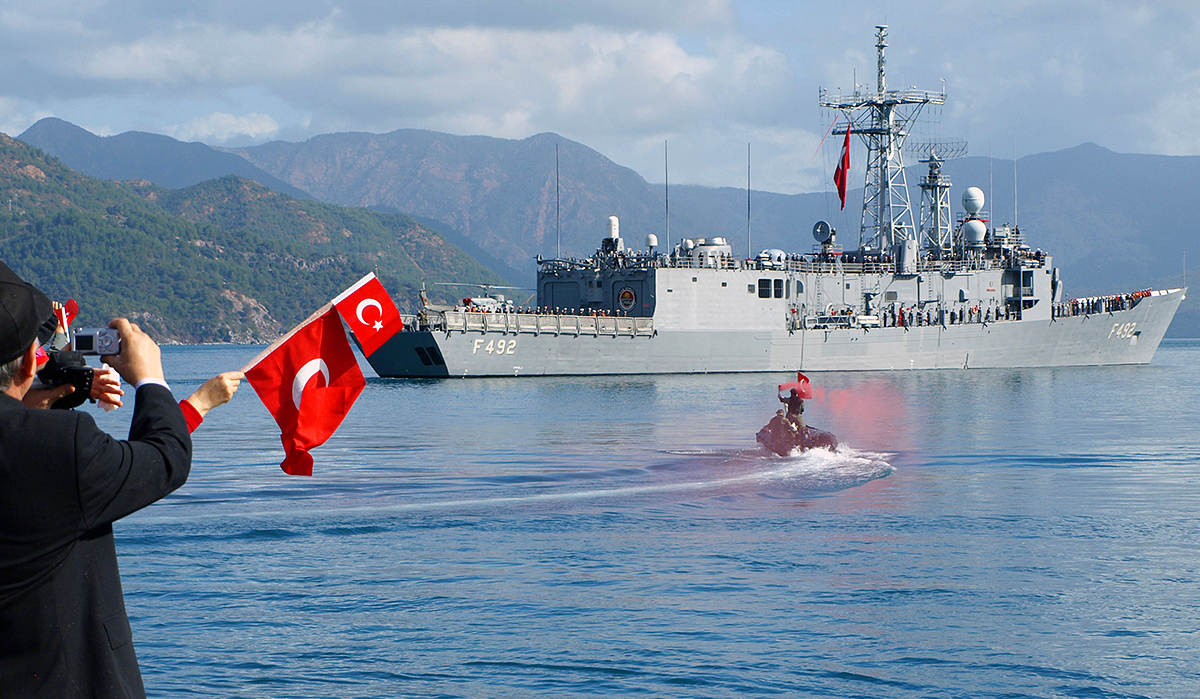As part of Turkey’s expansive “White Storm” naval exercises on the Black Sea, one of the Turkish Naval Force’s Type 209 submarines executed a sinking exercise (SINKEX) on the Knox class Frigate (Tepe class in Turkey) TCG Zafer F253. The attack was made via the employment of an advanced, all digital, fiber-optic wire-guided DM2A4 torpedo of German origin. As you can see, the torpedo detonated below the ship’s hull, heaving it upward and cracking it in two. A perfect kill.
Eight Tepe class frigates were acquired from the US in the mid-1990s as part of a holistic effort to modernize the Turkish Naval Forces—a program that began in the 1980s. The Zafer was commissioned in 1973 as the USS Thomas C. Hart FF-1092 before being acquired by Turkey 20 years later.
The video also shows an MH-60R helicopter taking out a small boat with a AGM-114 Hellfire, and one of Turkey’s new Ada class corvettes firing RIM-116 Rolling Airframe Missiles and its OtoMelara Super Rapid 76mm deck gun at aerial targets. Finally, it shows one of Turkey’s Gabya class frigates, which are surplus (and now highly upgraded) US-built Oliver Hazard Perry class ships, firing RIM-162 Evolved Sea Sparrow missile (ESSMs) and Standard SM-1 missiles.

Turkey has greatly modified their eight Gabya class frigates, including adding all new combat systems, plus data-links and sensors, including a modern long-range sonar and air search radar. These ships have also received an eight-cell Mark 41 vertical launch system. This gives the ships the ability to fire the highly advanced ESSM, with four rounds packed into each Mark 41 cell, giving the ship 32 missiles to fire. They also retain the ability to launch the SM-1s that are fired via the ship’s original Mark 13 rail launch system, with 40 rounds stored in a rotary magazine below deck.
Unlike America’s Oliver Hazard Perry class frigates, which were allowed to devolve into tactical obscurity before their retirement, Turkey and a handful of other countries have kept the class exceedingly potent and capable of area air defense. This, along with the fact that these ships were built tough, adhering to true naval warfare survivability standards, are things that America’s troubled Littoral Combat Ships lack.

We could learn a lesson from our allies who have to do more with less. Sometimes, the hype of a new weapons concept seems to take precedence over logical upgrades to existing platforms. Then again, no defense contractor is going to get rich upgrading existing gear, nor are higher-ups in the Pentagon likely to earn another star for their work on such a meager project. Still, even Turkey’s newest warship, the LCS-like Ada class, carries ESSMs, giving it the ability to protect itself and other ships around it at range even in higher-threat scenarios.
The Navy just won’t add this anti-air capability to the LCS, even as they have supposedly “up-gunned” the design, despite the fact that potential export customers have demanded it. As such, missions like convoy escort or operations in medium- and high-threat environments without a multi-billion dollar destroyer nearby are out of the question.
Contact the author Tyler@thedrive.com
